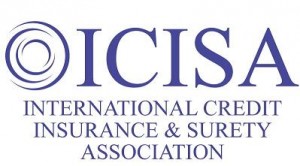Will Blockchain Disrupt the Surety and the Trade Credit Inurance Industry? Perhaps it will like many other industries unless the Surity and Credit Insuracne industry will use the Blockchain concept towards future growth and to reduce risk. With credit insurance being a major customer segment of credit information, it is only natural that the members of BIIA have a keen interest in the future prospects of Surety and Credit Insurance. BIIA thanks ICISA for sharing this article with us which was recently published in the ICISA INSIDER.
 By Emily Patterson: When the word blockchain comes up in a conversation, people automatically think about the crypto-currency Bitcoin. Blockchain in a very basic summary is a database that stores information about transactions between users. I am here to tell you that blockchain has many more functionalities outside the realm of keeping score of Bitcion transactions. Further into this article I will explain the core classifications of blockchain and what classification of blockchain I find to be most interesting for the surety industry.
By Emily Patterson: When the word blockchain comes up in a conversation, people automatically think about the crypto-currency Bitcoin. Blockchain in a very basic summary is a database that stores information about transactions between users. I am here to tell you that blockchain has many more functionalities outside the realm of keeping score of Bitcion transactions. Further into this article I will explain the core classifications of blockchain and what classification of blockchain I find to be most interesting for the surety industry.
Block Chain or Blockchain? Before we dive into the deeper content, it is important to define terminology so we are all on the same page. Satoshi Nakamoto, the mystery man behind the blockchain, wrote an article describing how Bitcoin, a type of digital currency, can be processed through a timestamp server by taking a hash of a block of items to be time-stamped and then would publish the hash to the public (Nakamoto, 2008). Not once did Satoshi Nakamoto describe the Bitcoin chain as blockchain in his article. The term ‘block chain’ is not officially coined until about 2010 in the online Bitcoin Forum where Satoshi Nakamoto would interact with other interested Bitcoin/Block Chain architects. However, as time passed, people began to use block chain and blockchain interchangeably. For this article we will use the term blockchain.
Is blockchain disruptive? Have you ever heard of the guy named Clayton M. Christensen? He introduced us to the theory of disruptive innovation in 1995. Christensen explained that ‘disruption’ is a process in which a smaller enterprise with fewer resources successfully challenges the already established market players and their ways of function. Let us use banks and blockchain as an example for this. Banks will usually improve their products and services for their most demanding and profitable customers. By doing this, the banks often overlook potentially important business segments. Thus, giving room for smaller entrants to target these overlooked segments to deliver a better solution. However, disruption is only then considered when mainstream consumers begin to embrace and use the new entrants solution in volume. In our example, the banks focused on business-to-business (B2B) and business-to-consumer (B2C) transactions and neglected the growing demand for peer-to-peer (P2P) transactions. Blockchain architects capitalized on this and found their way into the market. However, based on Christensen’s disruptive innovation theory, blockchain would not be considered disruptive just yet. Blockchain is not considered disruptive yet because the masses are not using P2P transactions or digital currency via a blockchain in their daily routine.
How does blockchain even remotely relate to the surety industry? In 2017, the researchers Hitoshi Okada, Shigeichiro Yamasaki, and Vanessa Bracamonte published an article proposing a classification of blockchains based on authority and incentive dimensions. In simple terms there are different types of blockchains, which can be used for different functionalities. The blockchain technology underlying Bitcoin is just one out of four blockchain classifications. So when I talk about blockchain within the surety industry, I am not necessarily talking about the Bitcoin blockchain. In the efforts to not turn this article into a thesis, I will explain two out of the four blockchain classifications. I will explain the blockchain used for Bitcoin and I will also explain the blockchain I find most interesting for the surety industry. The figure below presents a visual representation of how the four allocated blockchains are classified.
| Under an authority | Without an authority | |
| Market-based | e.g Sidechain | e.g Bitcoin |
| Non-market-based | e.g Consortium blockchains |
Source: Okada, H., Yamasaki, s. & Bracamonte, V. (2017). Proposed classification of blockchains based on authority and incentive dimensions. 2017 19th International Conference on Advanced Communication Technology (ICACT), 593-597. doi: 10.23919/icat.2017.7890159.
According to Okada, Yamasaki and Bracamonte, the Bitcoin blockchain that most of us heard of, is classified as being without an authority and as market-based. This means, because there is no authority, the blockchain needs to have an established market to set a price and to receive a form of reward. There needs to be some type of incentive if an authority is not involved to control the market. This is why mining is such an important part to the Bitcoin functionality. Mining in simple terms is when a person allows the public blockchain to use their computing power to solve a puzzle. The person whose hardware system solves the puzzle first gets to lay the next block on the blockchain and in turn for solving the puzzle receives Bitcoins as a reward.
The blockchain that I am currently researching for my doctoral thesis is a blockchain that is under an authority and that is non-market-based. In this specific blockchain there needs to be an alternative incentive other than mining to join and to remain within the system. The whole concept of ‘mining’ completely falls away in regards to this type of blockchain. In addition, without a market, there is no price mechanism. Since there is an authority within this blockchain system, the authority has the control to decide who is allowed to enter into the system and who is not and the authority can set the prices. For example, a construction company needs bonding for more than one project and needs bonding for the different phases of their multiple projects, i.e. bid bond, payment bond, performance bond, and maintenance bond. A concept between the surety, the construction company, and the different beneficiaries can be created to keep the bonds organized within the blockchain. In addition, this blockchain classification could potentially organize surety syndication programs. For example, if multiple sureties are on one blockchain with this said construction company and its beneficiaries. All sureties would have equal and transparent access to information stored on the blockchain, which would be useful in the case of when a claim is made.
Right now, I am in the beginning of my research concerning the blockchain under an authority and that is non-market-based. The examples that I have listed above are just a few preliminary ideas with no technical evidence. While the examples I provided are limited, I can briefly share some other examples of blockchains being used in other markets. One of the more successful examples is AXA teaming up with blockchain company Fizzy. In this case, someone pays for insurance on their flight, if their flight is delayed/cancelled then the person insured receives compensation from AXA. Behind the scenes, a blockchain is connected with a global flight tracker. Once a flight is delayed/canceled, the blockchain is triggered and the insured person instantly receives their compensation. Another example of blockchain within the insurance industry would be Fintech company Fluent teaming up with Euler Hermes. Fluent and Euler Hermes are partnering up to bring blockchain technology to the trade credit industry. The plan is to use a real-time credit insurance tool in combination with a blockchain ledger.
In summary, if you ask me if I think blockchain has the possibility to disrupt the surety industry, I would say yes. We have yet to see a true blockchain breakthrough, time will only tell. To be continued in 2020…
About the Author Emily Patterson
Emily graduated with both her Bachelors degree in Political Science and with her Masters in Business Administration (MBA) degree from the Saint Francis University in Pittsburgh, PA. Following university, Emily started working for Merrill Lynch as an investment associate for the Private Investment & Banking Group. In 2015 Emily moved to Germany and joined the Marsh German Surety Team, where she is a surety broker for 3 years now. In 2016 Emily decided to pursue a doctorate degree part-time at Sheffield Hallam University on the subject of blockchain within the surety industry. Emily is on track to finish her doctoral thesis by Fall of 2020.
Courtesy of ICISA – International Credit Insurance and Surety Association – Published in the June Issue of the ‘THE ICISA INSIDER’




























